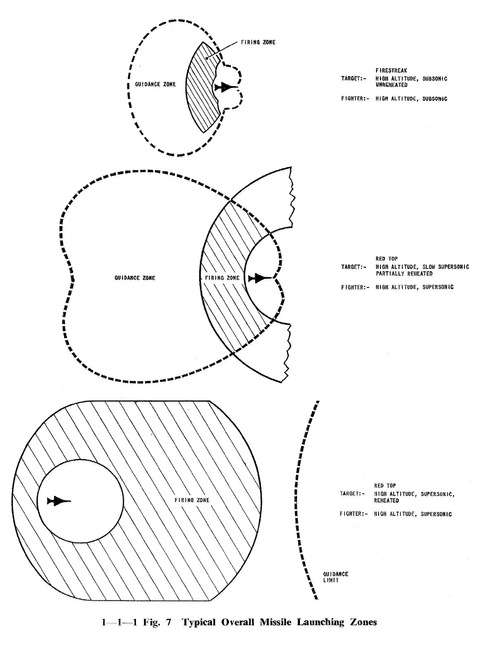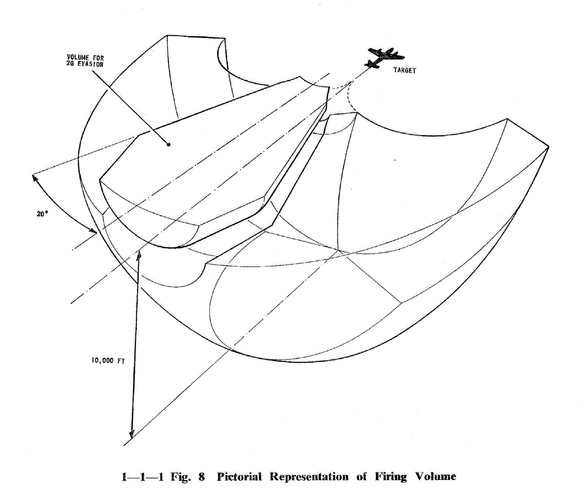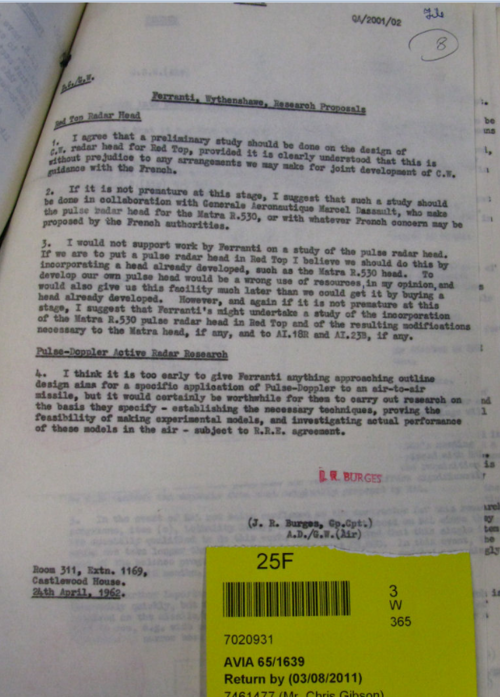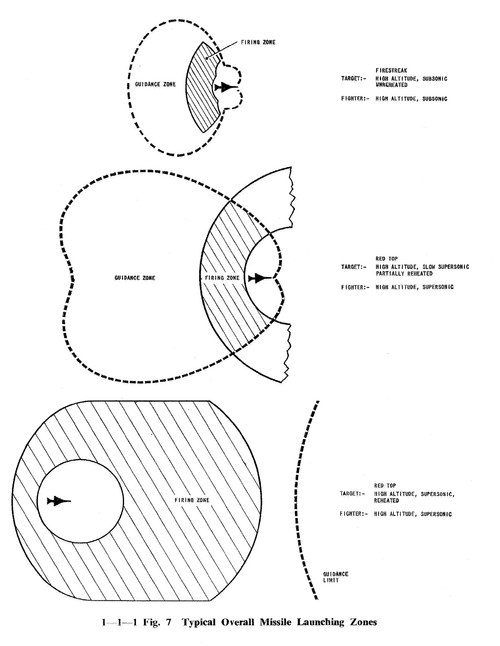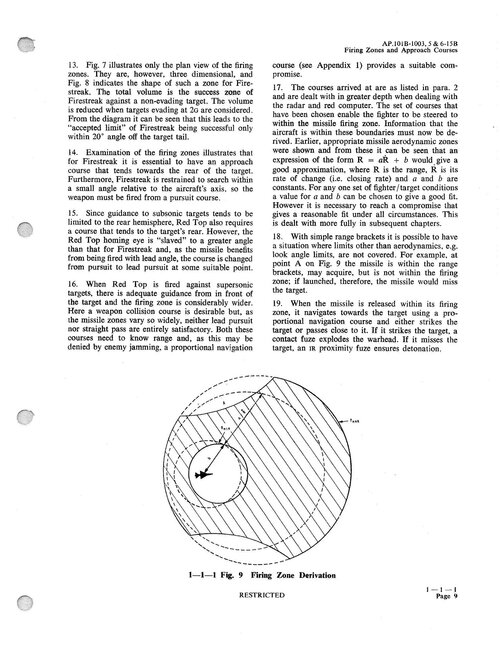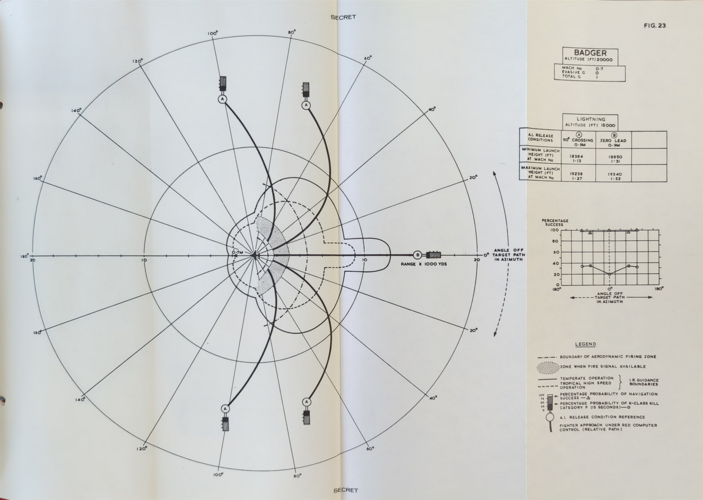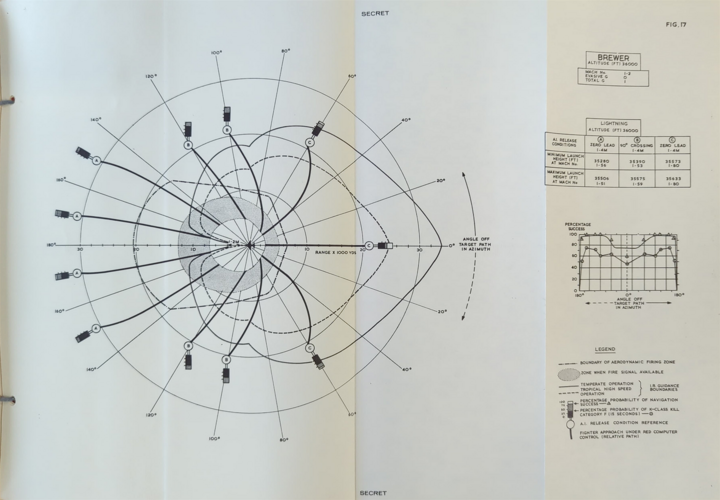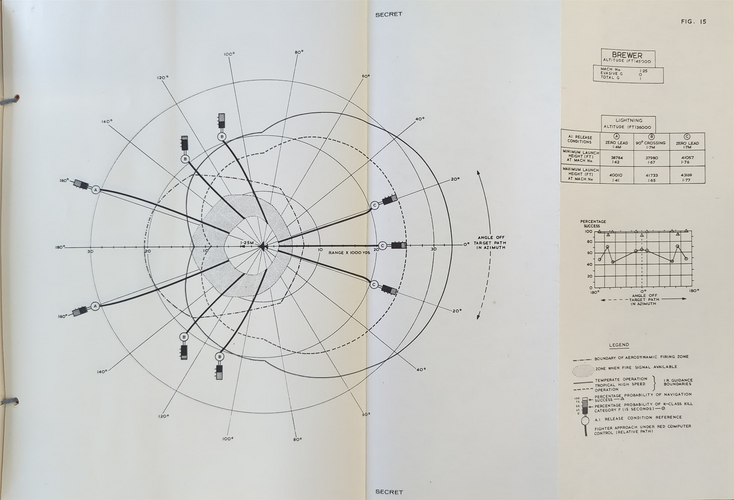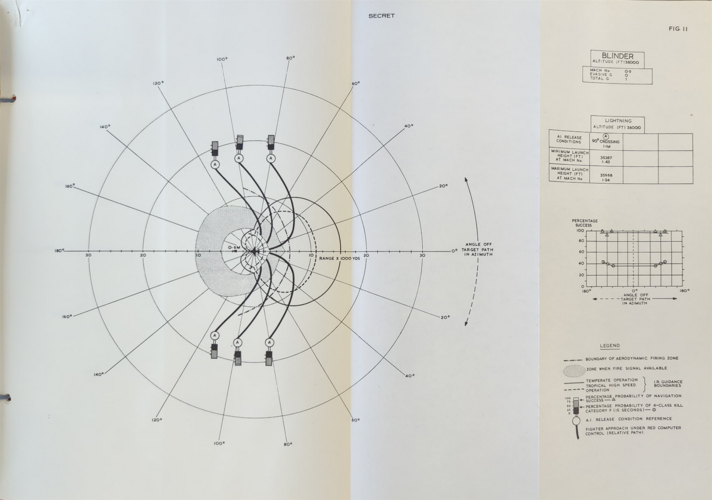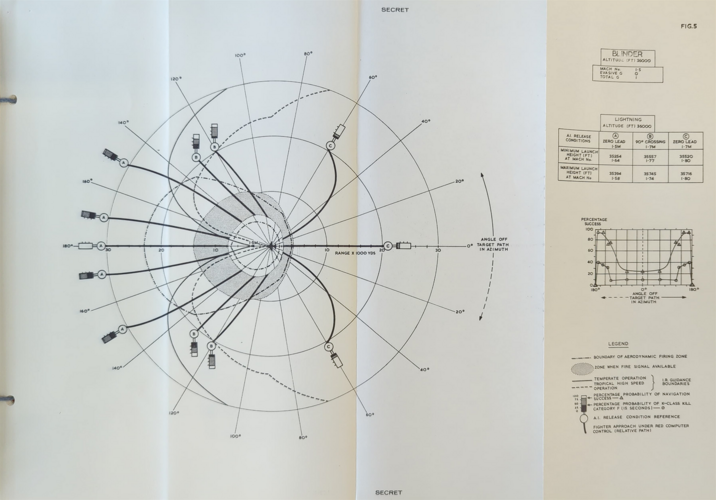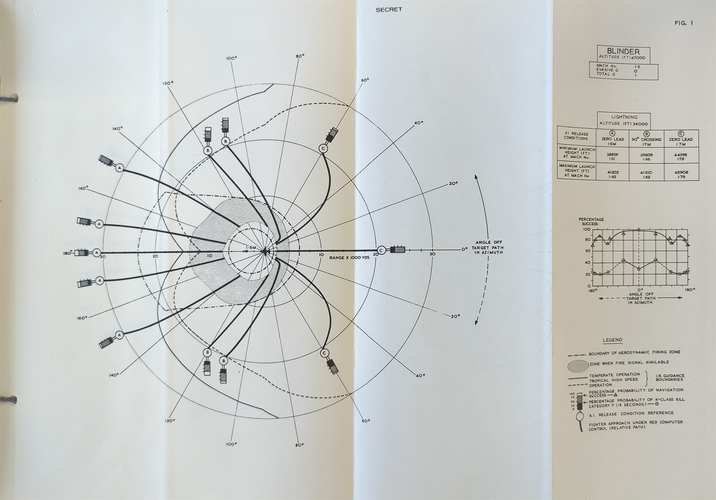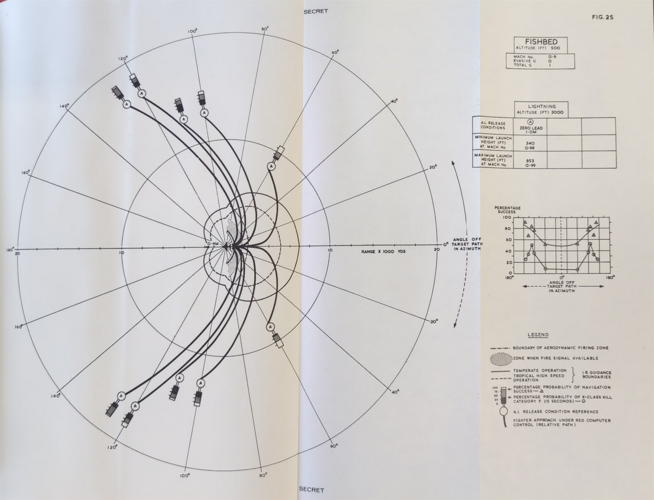You are using an out of date browser. It may not display this or other websites correctly.
You should upgrade or use an alternative browser.
You should upgrade or use an alternative browser.
Red Top missile Performance & All-Aspect Capability
- Thread starter GUNDAM123dx
- Start date
-
- Tags
- red top
A listing of Blue Jay variants and derivatives, including info from Tony Wilson's English Electric Lightning Genesis & Projects.
Blue Jay Mk.1 – stern-chase IR-guided, entered service as Firestreak.
Blue Jay Mk.2 – improved version with PbTe IR sensor with hemispherical nose, intended for DH.110, Hunter and Javelin for 1958. Some test firings but became test vehicle for Mk.4.
Blue Jay Mk.2A – proposal of Mk.2 with de-rated motor to reduce max speed.
Blue Jay Mk.3 – as Mk.2 with larger wings for launch at M1.7 at 60,000ft, intended for P.1B and SR53 for 1959. In August 1956 was proposed in two versions; semi-active radar guided (for RN) and IR-guided. Cancelled in 1957 to free development effort for Mk.4.
Blue Jay Mk.4 (Blue Vesta) – PbTe IR-seeker with look angle limited to 60° and larger wings of Mk.3 for launch at M2.0 at 60,000ft for 1961. In September 1956 was proposed in two versions; X-band CW homing with original Mk.1 wings for Sea Vixen and IR-guided with larger wings for 15,000-65,000ft altitude clearance for P.1B and P.177.
Blue Jay Mk.5 (Blue Dolphin) – re-designation of low-altitude CW-homer Mk.4 in July 1957, cancelled later that year.
Red Top – further development of Mk.4 from 1958 with an InSb IR sensor, entered service.
Red Top Mk.2 – May 1960 proposal to replace the solid fuel Linnet motor with a liquid fuel to improve shelf life and handling and improve thrust, proposed as a retrofit for existing missiles.
Red Top Mk.2 Plus – Mk.2 with an enlarged mid-section with a larger boost motor to improve speed to engage high-speed targets.
Radar Red Top – further development of Mk.5 during 1960-61 with a GEC CW seeker, effective at altitudes below 45,000ft and intended mostly for Sea Vixen.
Radar Red Top – 1964 proposal to fit the Matra 530 guidance head
Blue Jay Mk.2A - What did a de-rated motor and reduced max speed bring the the party?
- Joined
- 27 December 2005
- Messages
- 17,693
- Reaction score
- 25,986
Blue Jay Mk.2A - What did a de-rated motor and reduced max speed bring the the party?
Limit acceleration when launched from new supersonic interceptors in order to avoid overheating the missile due to aerodynamic friction.
Conspirator
CLEARANCE: L5
- Joined
- 14 January 2021
- Messages
- 324
- Reaction score
- 227
this is great stuff! housings, avionics data, performance data, how did you get all this?All from Lightning F.53 Pilots Notes & DEFE 69/489.
First, performance in Lightning F.53 Pilots Notes:
Maximum overload: 12G lateral acceleration / 7.5G without wings (20G when engine burning according to another source but not authoritative: http://www.loneflyer.com/2020/05/08/hawker-siddeley-red-top/) and rate of roll 30°/sec
Motor Burn time: 2.5 sec (basically 3 sec, you can search the thread about Linnet rocket engine in this forum - there is a document about it)
Max flight time: 30 sec
Seeker FOV: 5° / After launch warning: 1°
Seeker gimbal limit pre-launch: 30° unslaved; 30° slaved by AI23S (export version of AI23B), seeker "looking axis" parallel to A1 scanner axis
Seeker gimbal limit (post-launch): should be above 30°
Warhead explosive mass: 40lbs/18.14kg ( and there's also continous rod)
Proximity fuse range: 40ft/12m
( Here also mentioned "an all-round attack capability")
- Joined
- 27 December 2005
- Messages
- 17,693
- Reaction score
- 25,986
Lightning F.53 Pilots Notes:
DEFE 69/489:
DEFE 69/489:
- Joined
- 27 December 2005
- Messages
- 17,693
- Reaction score
- 25,986
Nice!Lightning F.53 Pilots Notes:
DEFE 69/489:
Would you by any chance have any manuals to do with the Saro SR.177 and/or the Hawker P.1121?
- Joined
- 27 December 2005
- Messages
- 17,693
- Reaction score
- 25,986
Given that I wrote a book on the P.1121 you can draw your own conclusionsNice!Lightning F.53 Pilots Notes:
DEFE 69/489:
Would you by any chance have any manuals to do with the Saro SR.177 and/or the Hawker P.1121?
Links I posted were found on the internet, though I did have copies of both already separately. I have quite a lot of AI23 stuff that didn't make the p.1121 book.
I don't have a copy of your book and I'd love purchase a copy so please get your publisher to print another run.Given that I wrote a book on the P.1121 you can draw your own conclusions
Will you post that on this forum?I have quite a lot of AI23 stuff that didn't make the p.1121 book.
- Joined
- 27 December 2005
- Messages
- 17,693
- Reaction score
- 25,986
- Joined
- 6 September 2006
- Messages
- 4,817
- Reaction score
- 9,379
Interesting. Sounds like Group Captain Burges had a brainstorming session in April 1962.Here the mention of R530 seeker from April 1962.
Wilson in his book that a proposal was made in March 1964 and from his paragraph it seems like compatibility with AI.23 had been checked and confirmed so presumably was an official DH/Ferranti study. So it sounds like Burges idea took a little while to get off the ground but did gain traction.
Plus Burges' minute seems to hint that Anglo-French cooperation in CW guidance was on the cards in 1962.
GUNDAM123dx
HAVE FUN
- Joined
- 31 October 2017
- Messages
- 62
- Reaction score
- 151
Any progress about the "20g" problem?The real problem is that, after many years, some web-sources disappeared... I will search for it in my archive, I'm also always interested in real data.
Does anyone know if there was ever any investigation into a ground launched Red Top akin to the MIM-72 Chaparral?
- Joined
- 26 January 2011
- Messages
- 2,239
- Reaction score
- 634
No. Why bother, when Rapier was just around the corner?Does anyone know if there was ever any investigation into a ground launched Red Top akin to the MIM-72 Chaparral?
No. Why bother, when Rapier was just around the corner?Does anyone know if there was ever any investigation into a ground launched Red Top akin to the MIM-72 Chaparral?
It could've been developed quickly as an interim short-range SAM.
- Joined
- 26 January 2011
- Messages
- 2,239
- Reaction score
- 634
The British were primarily worried about big bombers so they concentrated on heavy SAMs the same as the US did. They next worried about aircraft attacking their field armies so they developed a radar guided medium SAM (Thunderbird) and they then worried about low level attack and so Rapier was developed.No. Why bother, when Rapier was just around the corner?Does anyone know if there was ever any investigation into a ground launched Red Top akin to the MIM-72 Chaparral?
It could've been developed quickly as an interim short-range SAM.
Last edited:
- Joined
- 15 July 2007
- Messages
- 4,864
- Reaction score
- 4,501
Not much point.I suppose a tandem launch booster could've been developed for a surface launched version.
From Orange Nell onwards such short range quick reaction SAM Systems focused on the anti-missile mission.
Tripartite studies from the UK resolved into System A, B and C.
System B was Sea Wolf.
- Joined
- 27 December 2005
- Messages
- 17,693
- Reaction score
- 25,986
From National Archives AVIA 65 905 (Red Top) - this information is from development phase.
Seeker
Look angle: +-62deg
Band: 3.6 - 5 micron
Cell: Initially PbTe (Lead Telluride) but to be replaced with InSb (Indium Antimonide) for greater sensitivity and cheaper cost.
Fuse
Single window two beam system using a PbSe (Lead Selenide) detector cell.
Seeker
Look angle: +-62deg
Band: 3.6 - 5 micron
Cell: Initially PbTe (Lead Telluride) but to be replaced with InSb (Indium Antimonide) for greater sensitivity and cheaper cost.
Fuse
Single window two beam system using a PbSe (Lead Selenide) detector cell.
Last edited:
Here are some detailed Red Top firing range diagrams from the Release To Service Document (AIR 20/12527 at the National Archives). Provided the target is supersonic the front aspect range is quite impressive, considering the age of the missile.
Attachments
- Joined
- 27 December 2005
- Messages
- 17,693
- Reaction score
- 25,986
Its not bad for hot supersonic targets like a Blinder at Mach 1.5, or even a Mach 0.9 Blinder, but its pretty useless against a MiG-21 at 500ft from any direction.
but its pretty useless against a MiG-21 at 500ft from any direction.
500Ft? Are you talking about just firing at a MiG-21 from 500Ft (Well within the minimum firing firing distance of a Red Top) or 500Ft altitude?
but its pretty useless against a MiG-21 at 500ft from any direction.
500Ft? Are you talking about just firing at a MiG-21 from 500Ft (Well within the minimum firing firing distance of a Red Top) or 500Ft altitude?
He's referring to Red Top Diagram 7.png which shows the engagement envelope for a MiG-21 flying at 500 ft altitude. Maximum aerodynamic range from directly astern looks to be about 2,000 yards, which is not particularly good.
I know they serve somewhat different purposes, but how did Red Top compare to pre-L Sidewinders? I have trouble comparing some of the diagrams in this threat with these of AIM-9s, but it almost seems like Red Top has a lower kinematic range than AIM-9D? And that is not even getting into the sensor stuff and endgame performance.
red admiral
ACCESS: Top Secret
- Joined
- 16 September 2006
- Messages
- 1,781
- Reaction score
- 2,300
Where would it be illuminated from though?Red Top with GAR-3 seeker probably was more appropriate for Lightning.
Red Top seeker gave a most aspect shot capability rather than tailchase only like most contemporary IR missiles
Red Top with GAR-3 seeker probably was more appropriate for Lightning.
What makes you think the AIM-4E's seeker mounted on the Red Top would be better? Did the Lightning's AI radar have the room for an illuminator for a SARH missile?
For one, the GAR-3 was crude for a SARH, and like any fighter that would have a radar, integration of an illuminator is just one of the hurdles to such a change. Its not like Lightning wasn't around long enough to have figured it out.What makes you think the AIM-4E's seeker mounted on the Red Top would be better? Did the Lightning's AI radar have the room for an illuminator for a SARH missile?
One of the early replies to this thread is a scan of DEFE 69/489 which is basically the MOD evaluating whether to use Red Top or AIM-9D on the Phantom (do note however that they do not have fully detailed information available on either missile at the time of the discussion). The basic conclusion is that there Red Top has front aspect capability (which AIM-9D lacks) and a more lethal warhead, but AIM-9D is probably a bit better in the rear aspect. Ultimately the much increased weight and cost of Red Top swings them in favour of the AIM-9D.I know they serve somewhat different purposes, but how did Red Top compare to pre-L Sidewinders?
The Red Top does indeed have worse kinematic performance than the AIM-9D (particularly at low altitude). The seeker however is much more capable (limited all-aspect capability, better gimbal limits, ability to be slaved off-boresight prior to launch), and the Warhead is larger / more lethal.I have trouble comparing some of the diagrams in this threat with these of AIM-9s, but it almost seems like Red Top has a lower kinematic range than AIM-9D? And that is not even getting into the sensor stuff and endgame performance.
As you say they were designed for different purposes. The Sidewinder was meant to be a general purpose missile, while red Top was designed primarily for use against bomber's at high altitude (hence the significantly larger warhead and front aspect capability).
Last edited:
I think the IR Red Top was adequate for the Lightning's needs, it provided all-aspect capability against supersonic bombers and a SARH seeker would have been susceptible to ECM.Red Top with GAR-3 seeker probably was more appropriate for Lightning.
There was actually a SARH version of Red Top (as well as one with a boost-sustain motor) proposed for the Sea Vixen. The logic there was that as the Sea Vixen was subsonic all attacks against an unknown target (i.e. one jamming surveillance radars) would need to be made head on (because if the target turned out to be supersonic the Sea Vixen wouldn't be able to catch-up from behind). The argument was made that while that works fine with IR Red Top if the target did indeed turn out to be supersonic, should it instead turn out the target was subsonic you wouldn't be able to reliably get a front aspect lock. Hence it was argued a SARH version should be procured to allow for a true all-aspect capability on Sea Vixen.
It seems the SARH and boost-sustain Red Top projects never really went far though. I guess they were deemed unnecessary for the Lightning; as it was so quick it wouldn't have had a problem catching up with a target from behind if necessary.
P-STICKNEY
ACCESS: Confidential
- Joined
- 28 September 2008
- Messages
- 57
- Reaction score
- 102
AIM-4E and, for that matter, AIM-9C didn't use a separate illuminator, and got their illumination from the launcher's pulse radar.What makes you think the AIM-4E's seeker mounted on the Red Top would be better? Did the Lightning's AI radar have the room for an illuminator for a SARH missile?
P-STICKNEY
ACCESS: Confidential
- Joined
- 28 September 2008
- Messages
- 57
- Reaction score
- 102
With 4 CW-illuminated Sparrows (Which have a Home on Jam mode) for head-on shots, I doubt that there would be anything to gain from substituting Red Tops for the AIM-9sI'm just trying to imagine the F-4K and F-4M armed with Red Tops instead of AIM-9s.
Similar threads
-
Firestreak Missile Performance
- Started by GUNDAM123dx
- Replies: 3
-

